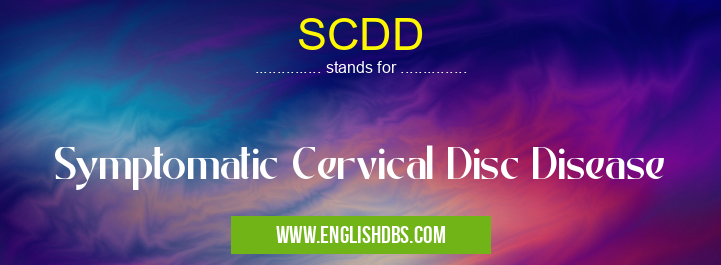What does SCDD mean in DISEASES
SCDD stands for Symptomatic Cervical Disc Disease, a medical condition characterized by pain and discomfort in the neck due to a damaged or herniated disc in the cervical spine (neck). This condition can result from various factors, including age-related degeneration, trauma, or repetitive strain. Understanding SCDD can help individuals recognize its symptoms, seek appropriate treatment, and manage related discomfort effectively.

SCDD meaning in Diseases in Medical
SCDD mostly used in an acronym Diseases in Category Medical that means Symptomatic Cervical Disc Disease
Shorthand: SCDD,
Full Form: Symptomatic Cervical Disc Disease
For more information of "Symptomatic Cervical Disc Disease", see the section below.
Symptoms of SCDD
SCDD typically presents with a range of symptoms, including:
- Neck Pain: Persistent pain in the neck, which may worsen with certain movements or positions.
- Headaches: Headaches stemming from the base of the skull, often accompanied by neck pain.
- Numbness or Tingling: Numbness or tingling sensations radiating down the arms or hands.
- Muscle Weakness: Weakness in the arms or hands, making daily activities challenging.
- Limited Range of Motion: Difficulty turning or bending the neck due to pain or stiffness.
Causes of SCDD
The primary cause of SCDD is damage or herniation of a disc in the cervical spine. Discs are soft, gel-like cushions located between the vertebrae in the spine and act as shock absorbers. As we age, discs naturally lose moisture and flexibility, becoming more susceptible to herniation or tearing. Other factors that can contribute to SCDD include:
- Trauma or injury to the neck
- Repetitive strain from work or activities
- Poor posture
- Obesity
Diagnosis and Treatment of SCDD
Diagnosing SCDD typically involves a physical examination, a review of symptoms, and imaging tests such as X-rays or MRI scans to visualize the cervical spine and identify any disc abnormalities. Treatment options for SCDD vary depending on the severity of symptoms and may include:
- Conservative Treatment: Non-surgical therapies, such as physical therapy, pain medication, and lifestyle modifications (e.g., posture correction, weight loss).
- Surgical Intervention: Surgery may be necessary in severe cases where conservative treatment fails to alleviate symptoms.
Essential Questions and Answers on Symptomatic Cervical Disc Disease in "MEDICAL»DISEASES"
What is Symptomatic Cervical Disc Disease (SCDD)?
SCDD is a condition where the intervertebral discs in the cervical spine (neck) become damaged or herniated, causing pain, numbness, and weakness in the neck, arms, and hands.
What are the symptoms of SCDD?
Symptoms can include pain, numbness, or tingling in the neck, arms, or hands; weakness in the arms or hands; difficulty with fine motor skills; and headaches.
What causes SCDD?
SCDD is typically caused by age-related wear and tear, but it can also be caused by injury or trauma.
How is SCDD diagnosed?
SCDD is diagnosed through a physical exam, medical history, and imaging tests such as X-rays, CT scans, or MRIs.
How is SCDD treated?
Treatment options include conservative measures like physical therapy, medications, and injections. In severe cases, surgery may be necessary.
Can SCDD be prevented?
While not always preventable, maintaining good posture, avoiding heavy lifting, and strengthening the neck muscles can help reduce the risk of developing SCDD.
What is the prognosis for SCDD?
With proper treatment, most people with SCDD can manage their symptoms and live active lives.
Final Words: SCDD, or Symptomatic Cervical Disc Disease, is a condition that can significantly impact an individual's quality of life. Understanding the symptoms, causes, and treatment options can empower individuals to seek timely medical attention and manage their discomfort effectively. While SCDD can be a challenging condition, with proper care and management, individuals can alleviate their pain and improve their overall well-being.
